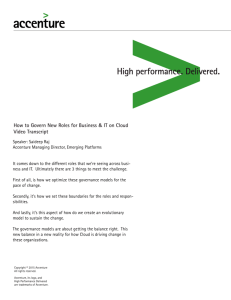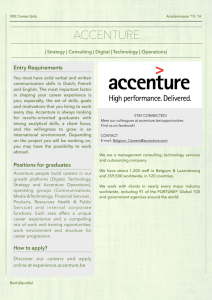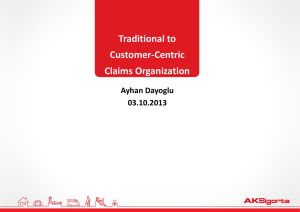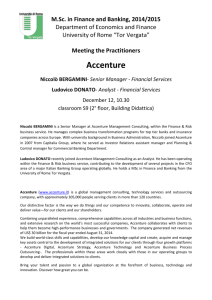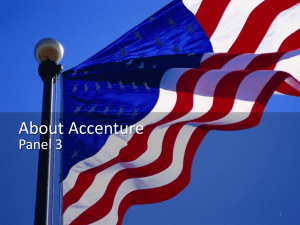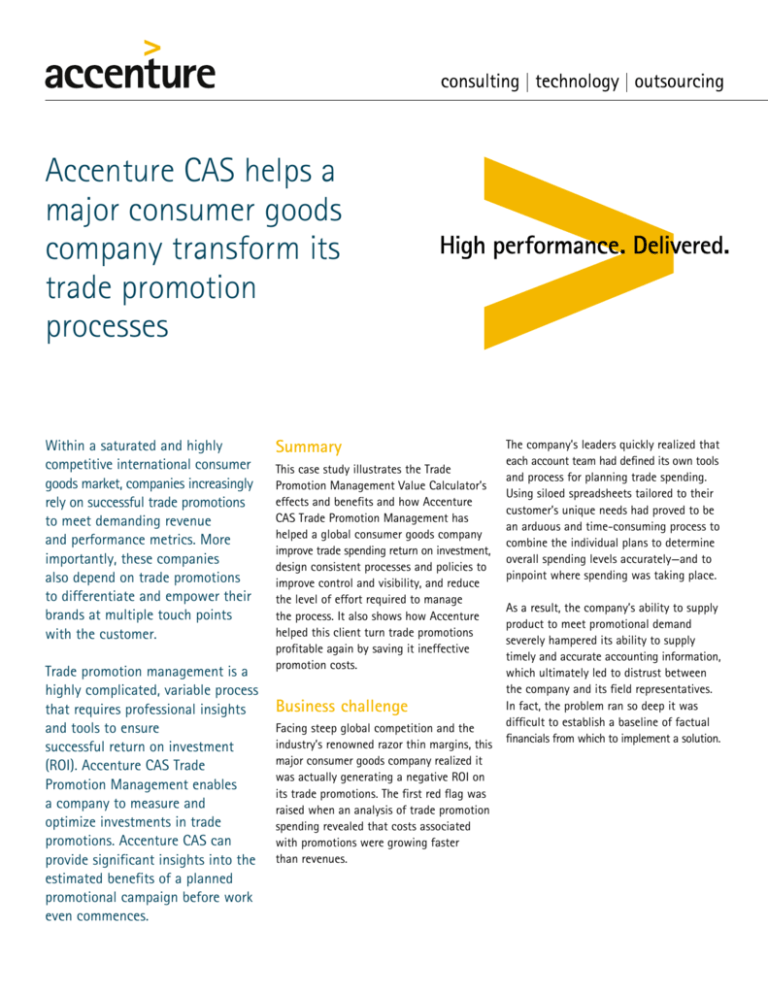
Accenture CAS helps a
major consumer goods
company transform its
trade promotion
processes
Within a saturated and highly
competitive international consumer
goods market, companies increasingly
rely on successful trade promotions
to meet demanding revenue
and performance metrics. More
importantly, these companies
also depend on trade promotions
to differentiate and empower their
brands at multiple touch points
with the customer.
Trade promotion management is a
highly complicated, variable process
that requires professional insights
and tools to ensure
successful return on investment
(ROI). Accenture CAS Trade
Promotion Management enables
a company to measure and
optimize investments in trade
promotions. Accenture CAS can
provide significant insights into the
estimated benefits of a planned
promotional campaign before work
even commences.
Summary
This case study illustrates the Trade
Promotion Management Value Calculator’s
effects and benefits and how Accenture
CAS Trade Promotion Management has
helped a global consumer goods company
improve trade spending return on investment,
design consistent processes and policies to
improve control and visibility, and reduce
the level of effort required to manage
the process. It also shows how Accenture
helped this client turn trade promotions
profitable again by saving it ineffective
promotion costs.
Business challenge
Facing steep global competition and the
industry’s renowned razor thin margins, this
major consumer goods company realized it
was actually generating a negative ROI on
its trade promotions. The first red flag was
raised when an analysis of trade promotion
spending revealed that costs associated
with promotions were growing faster
than revenues.
The company’s leaders quickly realized that
each account team had defined its own tools
and process for planning trade spending.
Using siloed spreadsheets tailored to their
customer’s unique needs had proved to be
an arduous and time-consuming process to
combine the individual plans to determine
overall spending levels accurately—and to
pinpoint where spending was taking place.
As a result, the company’s ability to supply
product to meet promotional demand
severely hampered its ability to supply
timely and accurate accounting information,
which ultimately led to distrust between
the company and its field representatives.
In fact, the problem ran so deep it was
difficult to establish a baseline of factual
financials from which to implement a solution.
How Accenture helped
As the Accenture team worked with the
client to define the project’s scope, they
balanced the need for rapid change with
the organization’s capacity for change.
Client team members included field sales,
sales operations, sales finance, corporate
finance and IT. A project steering committee
included the heads of Sales, Finance,
Marketing and Supply Chain to ensure
the solution reflected each function’s
requirements. The key project goals
focused on:
• Improving trade spending return on
investment
• Designing consistent processes and poli-
cies to improve control and visibility
• Reducing the level of effort required to
manage the process
Together, the teams established a set
of achievable end-state capabilities the
company hoped to achieve, with enough
flexibility in its foundation to build
and achieve capabilities that are more
advanced. The result was a three-phased
implementation approach.
1. Building the foundation
The consumer goods company’s trade
promotion transformation program was
pursued based on facts. To accomplish
this, the work began with a deep dive into
promotion performance. In parallel, the
team documented current processes and
time spent planning, managing and analyzing
trade promotion plans. This initial work
confirmed that each account team had
developed an individual approach to planning,
and it provided a critical benchmark necessary
to measure redesigned processes.
2. Creating process transformation
The team focused on creating a consistent,
sustainable trade promotion process
that would address three key areas:
1) Fund allocation
2) Account planning
3) Settlement
As the processes were defined, detailed
functional and data requirements were
determined. In parallel, use cases were
developed to cover the range of options
the client might require, both now and in
the future.
Similarly, various settlement options were
designed, including off-invoice, credit
memo and bill back/check, to provide a
range of settlement options. Finally, the
team documented requirements from
adjacent processes, such as sales and
service operation (S&OP) and finance,
to ensure data requirements could be
addressed through the new trade promotion
processes and metrics.
3. Implementing trade promotion
transformation
During the initial phases, the team had spent
considerable time defining the functional
requirements for the third phase and the
ultimate objectives of the trade promotion
transformation. Desired future-state
capabilities implemented included:
• Automated post-event ROI analysis
• Enhanced tracking metrics for measuring
event and overall plan efficiency
• Specific processes for planning new and
special pack item
• Event and plan optimization capabilities
(best results with a given investment)
The initial ROI analysis demonstrated the
power and potential of predictive analytics
to improve future promotion event
profitability. The new approach represented
a significant change and required retraining.
Consistent with the focus on building
only foundational capabilities, the team
designed a promotion-modeling tool for
use with those accounts where syndicated
data is available. The tool models
anticipated consumer demand based
on a set of promotion inputs using a set
of proprietary algorithms.
A tighter control on funding levels across
accounts has limited incentives for retailers
to divert products. As a result, diversion
was cut in half. By allocating those funds
that had been wasted and diverted in the
past to an average account, the benefit
equates to an 8 to 12 percent increase in
promotional spending.
High performance delivered
The manufacturer also noted other significant
benefits resulting from the transformation
project, including:
The Accenture CAS platform was the ideal
choice for meeting software requirements
that needed to be highly configurable and
fiscally reasonable. Moreover, Accenture
CAS brought added value no other vendor
could offer by:
• Providing a unique level of understanding
regarding trade promotion management,
with a real-world, practical approach
• Proving its success through similar
deployments and a clear development
roadmap
• Being highly configurable versus
requiring custom code
Following the implementation, the
consumer goods company improved
trade promotion spending by roughly
22 percent. In addition, two other KPIs
produced strong results: reduction in retailer
diversion and more efficient processes at
the retail execution level.
Copyright © 2012 Accenture
All rights reserved.
Accenture, its logo, and
High Performance Delivered
are trademarks of Accenture.
Now that processes are more efficient, the
client has freed up a substantial amount
in additional sales labor, which can be
redeployed to higher-value activities.
• Reduced back-office time spent on pay-
ments and post-audit deductions
• Reduced post-audit claims
• Fewer unauthorized deductions
• Improved forecast accuracy, resulting in
reduced working capital in safety stock
• More accurate promotion production
plans, particularly for custom displays
For further information, please contact:
Adrian Goodliffe
Senior Executive
adrian.goodliffe@accenture.com
+44 7736 667995
Or visit www.accenture.com/accenturecas
About Accenture
Accenture is a global management consulting, technology services and outsourcing
company, with approximately 246,000 people serving clients in more than 120 countries. Combining unparalleled experience,
comprehensive capabilities across all industries and business functions, and extensive
research on the world’s most successful
companies, Accenture collaborates with clients to help them become high-performance
businesses and governments. The company
generated net revenues of US$25.5 billion
for the fiscal year ended Aug. 31, 2011. Its
home page is www.accenture.com.
www.accenture.com.


